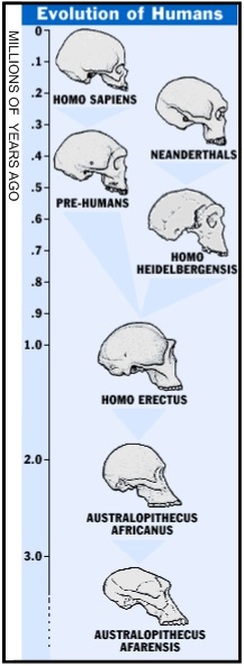Early Humans Homo Habilis

Review: What is the difference between a fossil and an artifact?
Homo habilis - “HANDY MAN”
1.8 - 1.6 million BCE
The first true humans! The first toolmakers! The Stone Age! This early man lived in Africa.
Man did not have strong claws to help him fight. He could not outrun saber-toothed tigers or cave lions. Man had to get smart to survive.
What foods did the early stone age people eat?
Homo habilis is credited with creating stone tools to help him live more comfortably, and to better protect himself against the many meat eating animals (carnivores) of the time. Although this group made stone tools and weapons, these weapons were still pretty basic. They did not grow crops. Their main diet was probably fruits, roots, nuts and vegetables that they found growing wild.
Homo habilis - “HANDY MAN”
1.8 - 1.6 million BCE
The first true humans! The first toolmakers! The Stone Age! This early man lived in Africa.
Man did not have strong claws to help him fight. He could not outrun saber-toothed tigers or cave lions. Man had to get smart to survive.
What foods did the early stone age people eat?
Homo habilis is credited with creating stone tools to help him live more comfortably, and to better protect himself against the many meat eating animals (carnivores) of the time. Although this group made stone tools and weapons, these weapons were still pretty basic. They did not grow crops. Their main diet was probably fruits, roots, nuts and vegetables that they found growing wild.
Since they did not have fire-making skills, they had to wait until they found something burning from natural causes, set aflame, for example, from a lightening strike. A campfire had to be carefully watched, because if the fire went out, they did not know how to start it again. The area around the campfire was probably used as a sleeping area. Because most animals are afraid of fire, a roaring campfire would keep most wild animals away.
What are three things that Homo habilis did for protection?
What are three things that Homo habilis did for protection?

When they broke camp, they probably attempted to bring their fire with them by carrying several lit branches. When they stopped again, they would start a new campfire . If their branches went out, they did without fire until they found something burning somewhere.
What evidence leads scientists to believe that Homo habilis was always on the move in search of food?
Remains of their campfires have been found and dated. Scientists have found stone tools at these sites! Animal bones have been found, as well. Technically, although animal bones would be called “trash,” they indicate that Homo habilis hunted game and/or scavenged fat-rich marrow from bones. These remains also tell us that Homo habilis probably did not stay in one place very long, but was always on the move, in search of food.
What evidence leads scientists to believe that Homo habilis was always on the move in search of food?
Remains of their campfires have been found and dated. Scientists have found stone tools at these sites! Animal bones have been found, as well. Technically, although animal bones would be called “trash,” they indicate that Homo habilis hunted game and/or scavenged fat-rich marrow from bones. These remains also tell us that Homo habilis probably did not stay in one place very long, but was always on the move, in search of food.
|
Activity: For this lesson's activity, please complete the third row of the Early Humans Comparison Chart you began with your last lesson.
|
|


